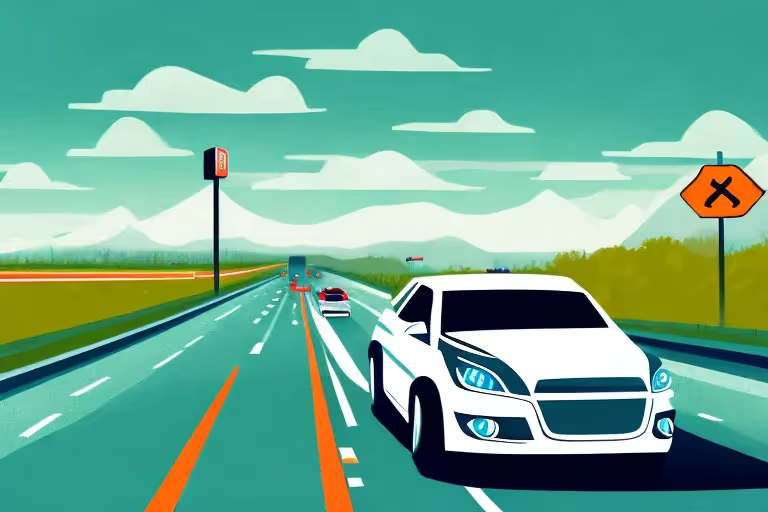Highway hypnosis is a phenomenon that many people may have experienced without even realizing it. It refers to a trance-like state that occurs when driving on long, monotonous stretches of road, where the driver becomes involuntarily zoned out and loses awareness of their surroundings. This article aims to provide an overview of highway hypnosis, exploring its concept, causes, symptoms, dangers, and prevention methods.
Understanding the Concept of Highway Hypnosis
Definition and Brief History
Highway hypnosis, also known as white line fever or driving trance, is a fascinating phenomenon that occurs during prolonged, repetitive driving. It was first described in the 1920s, a time when long-distance car travel became more common. People started to notice that during these monotonous journeys, they would sometimes enter a trance-like state, where their attention became fixated on the road ahead.
This state of unintentional hypnotic focus became known as "highway hypnosis," a term coined to capture the feeling of being in a trance while driving on long, straight highways. As more and more people embarked on cross-country road trips, the prevalence of this phenomenon increased, leading researchers to delve deeper into its causes and effects.
One interesting aspect of highway hypnosis is that it can occur regardless of the distance traveled. While it is commonly associated with long, cross-country drives, it can also happen during short commutes or familiar routes. The repetitive nature of the journey seems to be the key factor in triggering this state of mind, as the brain becomes accustomed to the monotonous scenery and the continuous motion of the vehicle.
Common Misconceptions about Highway Hypnosis
There are several misconceptions about highway hypnosis that need to be clarified to gain a better understanding of this intriguing phenomenon. Firstly, it is important to note that highway hypnosis is not a form of sleep or fatigue. Drivers in this state are fully awake and conscious, but their attention becomes fixated on a single point. It's almost as if their subconscious mind takes over the task of driving, while their conscious mind drifts away.
Furthermore, highway hypnosis is not limited to experienced drivers. It can happen to anyone, regardless of their driving expertise. In fact, even the most skilled and attentive drivers can find themselves slipping into this trance-like state when faced with long stretches of monotonous road. It is a natural response of the brain to the repetitive nature of the task at hand.
Another misconception is that highway hypnosis is limited to highways. While the term itself suggests a connection to highways, this phenomenon can occur on any road that lacks variety and stimulation. Whether it's a long, straight highway or a familiar suburban street, the brain can enter this state of focused attention, where the surroundings seem to fade away and the road becomes the sole point of focus.
In conclusion, highway hypnosis is a captivating concept that has intrigued researchers and drivers alike for decades. It is a state of unintentional hypnotic focus that can occur during prolonged, repetitive driving. By understanding the definition, history, and common misconceptions surrounding this phenomenon, we can gain valuable insights into the complexities of the human mind and its response to monotonous tasks.
The Science Behind Highway Hypnosis
Highway hypnosis, also known as "white line fever," is a fascinating phenomenon that occurs when drivers enter a trance-like state while driving on long, monotonous stretches of road. The combination of monotony and fatigue plays a significant role in inducing this state, causing drivers to lose awareness of their surroundings and enter a sort of autopilot mode.
The Role of Monotony and Fatigue
Monotony is a powerful trigger for highway hypnosis. When the brain is exposed to repetitive visual stimuli, such as the patterns of road markings or the drone of the engine, it can lead to a state of reduced attention and automatic behavior. The constant repetition of these stimuli can lull the brain into a state of relaxation, making it more susceptible to the hypnotic effects of the road.
Furthermore, fatigue plays a crucial role in the occurrence of highway hypnosis. When drivers are tired, their cognitive functions become impaired, making it more difficult to maintain focus and attention. The combination of monotony and fatigue creates the perfect conditions for drivers to slip into a trance-like state, where their actions become automatic and their awareness of the road diminishes.
The Psychological Aspect of Highway Hypnosis
Psychologically, highway hypnosis can be attributed to a phenomenon known as "automaticity." Automaticity is the brain's ability to perform routine tasks with minimal conscious effort, allowing it to focus on other activities or thoughts. When driving becomes a repetitive task, the brain can switch into automatic mode, leading to decreased awareness and an altered state of consciousness.
During highway hypnosis, the brain essentially goes on autopilot, relying on ingrained driving habits and muscle memory to navigate the road. This shift in consciousness can be compared to daydreaming, where the mind wanders off into its own thoughts while the body carries out familiar actions. In this state, drivers may not even realize how much time has passed or how far they have traveled.
It is important to note that highway hypnosis is not limited to long road trips or monotonous highways. Even short commutes on familiar routes can induce this trance-like state if the conditions are right. The brain's automatic response to repetitive tasks can occur in various driving scenarios, making it essential for drivers to remain vigilant and take regular breaks to combat the onset of highway hypnosis.
In conclusion, the science behind highway hypnosis is a complex interplay of monotony, fatigue, and automaticity. Understanding these factors can help drivers recognize the signs of highway hypnosis and take necessary precautions to prevent accidents. So, next time you embark on a long drive, remember to stay alert, take breaks, and keep your mind engaged to avoid falling victim to the intriguing phenomenon of highway hypnosis.
Symptoms and Signs of Highway Hypnosis
Recognizing the Early Signs
Recognizing the early signs of highway hypnosis is crucial for preventing potential accidents. Some initial indicators include difficulty recalling the past few miles, having little or no memory of recent driving events, and a sense of time distortion. Drivers may also experience a loss of concentration, glazed eyes, or a fixed gaze on the road ahead.
Physical and Mental Symptoms
Physically, highway hypnosis can manifest in yawning, heavy eyelids, slowed reaction times, and decreased muscle control. Mentally, drivers may feel mentally detached, daydreaming, or experiencing an altered state of consciousness. These symptoms can pose a grave danger, impairing the ability to respond to sudden traffic changes or hazards.
The Dangers of Highway Hypnosis
Impact on Driving Skills and Safety
The dangers of highway hypnosis cannot be overstated. As drivers enter a trance-like state, their ability to stay alert and react quickly to potential dangers diminishes significantly. This increases the risk of accidents, as they may fail to notice pedestrians, changing road conditions, or other hazards on the road. Moreover, the monotony of highway hypnosis can lead to a false sense of security and overconfidence, making drivers more susceptible to careless mistakes.
Real-life Incidents and Statistics
Several real-life incidents that have occurred as a result of highway hypnosis further highlight its dangers. Numerous accidents have been attributed to drivers falling asleep at the wheel or being unable to respond promptly to unexpected situations. Statistics indicate that around 20% of all road accidents involve drowsy or fatigued drivers, with highway hypnosis being a significant contributing factor in these cases.
Preventing and Overcoming Highway Hypnosis
Tips for Long Distance Drivers
For long-distance drivers, adopting preventative measures is essential to minimize the risk of highway hypnosis. Taking regular breaks every two hours or 100 miles can help combat fatigue and refresh the mind. Engaging in stimulating activities such as listening to upbeat music, engaging in conversation with passengers, or even opening the window for fresh air can help keep the brain active and alert.
The Role of Regular Breaks and Rest
Regular breaks and rest not only prevent highway hypnosis but also contribute to overall road safety and driver well-being. Adequate sleep before embarking on a long journey is crucial, as sleep deprivation can exacerbate the likelihood of entering a trance-like state while driving. By prioritizing rests and ensuring drivers are in a physically and mentally refreshed state, the risk of highway hypnosis can be significantly reduced.
Ultimately, understanding the concept of highway hypnosis, its causes, symptoms, dangers, and prevention methods is vital for all drivers. By remaining aware of these factors and implementing effective strategies to combat the trance-like state induced by monotonous driving, we can ensure safer roads for everyone.
In order to enhance your overall well-being, the Aura Health app offers a variety of tools and resources to help you relax, unwind, and stay focused. With features such as guided meditations, sleep aids, and stress management techniques, Aura Health can assist you in reducing stress and maintaining a healthy mental state. Download the app today to unlock the benefits of mindfulness and meditation in your daily life.
Aura is Your All In One App for Meditation, Mindfulness Wellbeing
Find peace every day with one app for your whole well-being. There is no one-size-fits-all solution to mental well-being. Aura is the first all-in-one wellness app that learns how to best help you. Discover an endless library of expert-created tracks for your well-being, all taught by the world’s best coaches, therapists, and storytellers. With Aura's personalized recommendations, you can find peace every morning, day and night.



.webp)






.avif)

%20(1).avif)


.avif)
.avif)
.webp)


.avif)


















































































































.avif)

















.svg)









